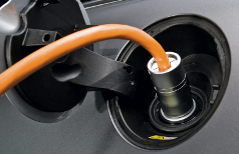 The United States has more plug-in electric vehicles than any country in the world. Since 2010, about 50,000 highway-capable plug-in electric cars have been sold in this country, but that’s a mere 0.28 percent of all car sales. Electric competition is essential for wide-spread adoption of electric cars.
The United States has more plug-in electric vehicles than any country in the world. Since 2010, about 50,000 highway-capable plug-in electric cars have been sold in this country, but that’s a mere 0.28 percent of all car sales. Electric competition is essential for wide-spread adoption of electric cars.
Open competition between electricity generators will help keep the cost of fuel down. Electricity markets are also responsible for spurring the development and adoption of demand response tools where users can see the real-time price of electricity and adjust their charging patterns to realize further savings.
In order for the electric car to be accepted on a wide-scale, low energy costs are a must. Under the old monopoly system, prices are controlled by regulators rather than generators competing to undercut the price of the other. Competition will ensure rates stay as low as possible and that electric car users will spend much less on fuel than today’s drivers. Currently, electric car owners spend the equivalent of $1 per gallon of gasoline.
The introduction of electric choice has also unleashed a flurry of technological improvements including demand response tools. These devices allow constant two-way communication between your home and your electric company instead of the once-a-month reading of your meter. In practice, electricity doesn’t cost the same at 2:00pm as it does at 9:00pm when many businesses are closed. Demand response technology allows the individual to see the shift in price and anticipate the best time to “fill-up” or charge their car, which will probably be at night when extra power is available on the grid.
There’s still time for more states to open to competition and demand response systems to be more widely deployed as electric car sales slowly gain momentum. Still, the pace of electric car sales is faster than the pace of hybrid vehicles when they first came on the market back in 2000. The most popular electric vehicle is the Chevy Volt plug-in hybrid with 24,345 units sold through September, followed by the Nissan leaf and the Toyota Prius plug-in hybrid
The gradual adoption of electric vehicles is good news for electricity rates since grid planners will have time to upgrade the nation’s infrastructure with resources and consumer usage data that they now have thanks to efficiencies created from electric competition. The last major grid upgrade occurred with the introduction of air conditioning.
Despite the decades since the wide-spread us of air conditioning, neighborhood transformers will still be able to handle at least one electric vehicle per neighborhood. But in the future, owners won’t just recharge their electric cars at home; they will also need public charging stations when car batteries run low. That means more grid upgrades and more increases in the demand for electricity.
Electric competition is doing much more than lowering your home or business’ electricity bill, it’s helping to recreate the way we consume energy in all aspects including our transportation. Without electric competition, many of the advances needed to sustain a large contingent of electric vehicles would not be viable with today’s power grid.


